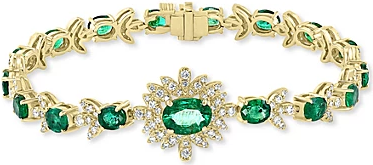The standard for determining the value of colored gemstones is not the same as for diamonds. A diamond is a single chemical element: carbon, and setting its value is strict and straightforward, namely defined by the 4 "c"s of cut, carat, clarity, and color.
However unlike diamonds, colored gemstones are not a single chemical element, but a combination of elements, as well as, falling into different families of stones. The most important characteristic in determining a colored gemstone's value is not clarity but color.
While clarity is a consideration in evaluating the value of colored gemstones, it is a less important factor than it is for diamonds. In other words, inclusions (or internal flaws) are expected and more accepted in colored gemstones, as opposed to, diamonds.
What's more certain families (a/k/a categories or types) of colored gemstones have more inclusions than others.
The GIA (Gemological Institute of America) doesn't rate colored gemstones like they do diamonds, nevertheless, they have created a system for classifying colored gemstones into 3 types based on clarity, i.e., their inclination or natural tendency to have internal flaws. Let's discuss them!
Type 1 are gemstones forming under the mildest geologic events and are found free of inclusions. They are eye clean and any inclusions they may have are so minor they are also loupe clean. It would take a powerful scope to detect any inclusions that exist. Type 1 gemstones include tanzanite, aquamarine, morganite, chrysoberyl, heliodor, blue zircon, blue topaz, and smoky quartz.Type 2 gemstones form under more difficult geologic events and have more inclusions than type 1, but are still eye clean. Corundum (sapphire, ruby), quartz (amethyst, citrine), alexandrite, spinel, peridot, all zircon except blue, and garnet are examples of Type 2 gemstones. Inclusions may be seen with a loupe and are accepted as long as they don't take away from the beauty of the stones.
VVS – Very Very Slight Inclusions
VS – Very Slight Inclusions
SI – Slight Inclusions
I – Inclusions
TS – Translucent
O – Opaque























































